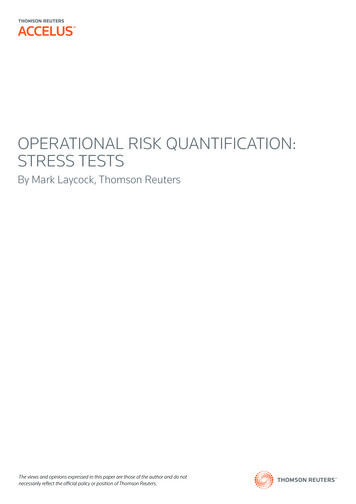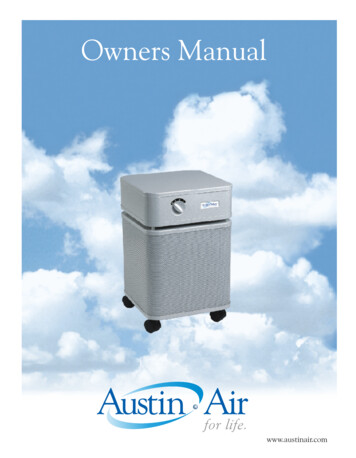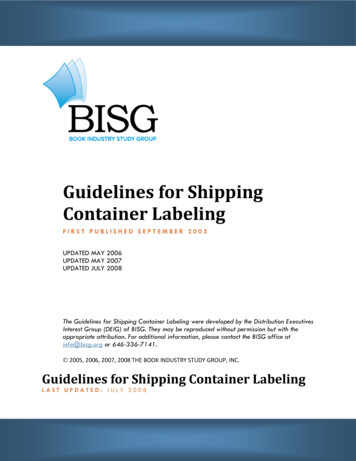
Transcription
Operational risk assessment forshipping in Arctic watersby Bushra KhanA thesis submitted to the School of Graduate Studies in partialfulfillment of the requirements for the degree ofPh.D. in Oil and Gas Engineering, Faculty of Engineering andApplied ScienceMemorial University of NewfoundlandMay 2020St. John’s, Newfoundland and Labrador, Canada
AbstractArctic navigation has many complexities due to its particular features such as ice,severe weather conditions, remoteness, low temperatures, lack of crew experience,and extended period of darkness or daylight. For these reasons, vessels, such as oiltankers, dry cargo ships, offshore supply vessels, research vessels, and passengerships operating in the Arctic waters may pose a high risk of collision with ice andother ships causing human casualties, environmental pollution and the loss of assets.This thesis presents a conceptual framework that is focused on collision modelling.In order to understand the process of risk escalation and to attempt a proactiveapproach in constituting the collision models for Arctic navigation, the present thesisidentifies various risk factors that are involved in a collision. Furthermore, the thesisproposes the probabilistic framework tools that are based on the identified risk factorsto estimate the risks of collision in the Artic. The proposed frameworks are used tomodel the collision based risk scenarios in the region. They are developed with theuse of Bayesian Networks, the Nagel-Schreckenberg (NaSch), and Human FactorAnalysis and Classification (HFACS) models. In the present thesis, the proposedmodels are theoretical in nature, but they can be useful in developing a collisionmonitoring system that provides a real time-estimate of collision probability thatcould help avoid collisions in the Arctic. Further, the estimated probabilities are alsouseful in decision making concerning safe independent and convoy operations in theregion.i
The proposed frameworks simplifies maritime accident modeling by developing apractical understanding of the role of physical environment, navigational andoperational related aspects of ships, and human errors, such as individual lapses,management failures, organizational failures, and economic factors in the collisionrelated accidents in the Arctic.This research also identifies the macroscopic properties of maritime traffic flow anddemonstrates how these properties influence collision properties. The thesis alsopresents an innovative accident model for ice-covered waters that estimates thecollision probability and establishes the relationship between the macroscopicproperties of the traffic flow with the contributory accidental risk factors in the region.The main focus of the present thesis is, to better understand, communicate, andincorporate specific risk factors into the maritime risk assessment processes, involveshipping organizations to agree on best practice methodologies and make the datasources easily available, and modify the Arctic risk management processes byimplementing effective risk assessment techniques and appropriate risk treatment.ii
DedicationThis thesis is dedicated to my beloved parents, my father, Professor Dr. Shafique AliKhan (late) and my mother, Tanveer Pirzadi (late)iii
AcknowledgmentsIn the name of Allah (the God), the Most Beneficent, the Most Merciful. All praise beto Allah (the God) alone, the Sustainer of all the worlds, most Compassionate, everMerciful, and I send salutations upon His noble prophet Muhammad peace be uponhim.I could not have accomplished this work as presented here had it not been for the expertsupport and constant encouragement from my supervisors Dr. Faisal Khan and Dr.Brian Veitch. Their enormous research experience and knowledge have brought me tothink seriously on the problem I have taken up in this thesis. Also, their diverse interestshelped me think over a problem with different perspectives. I would always rememberthe way they guided me through all this process. It has been a pleasure working undertheir supervision.I would also like to thank all of my fellow colleagues at Lloyd’s Register Foundation(LRF) group at Memorial University of Newfoundland, for their valuable help andsuggestions for improving this work. Thanks to the LRF group, National Sciences andEngineering Research Council of Canada, and the Canada Chair Program for theirfinancial support.In the last, I would like to extend my deepest and sincere thanks to my elders,Muhammad Hanif Shah Saheb, my late parents my father Prof. Dr. Shafique AliKhan and my mother Tanveer Pirzadi for their endless prayers, encouragement, andmoral support. I would also like to thank Miss. Basharat Khan, my younger sister foriv
her prayers and moral support. I know without her love and sincere prayers I wouldnever be able to perform this scholarly activity.I would like to thank my husband Dr. Syed Nasir Danial for his constant support, love,and care, for all the late nights and early wakeups to keep me calm over the course ofthis study. I thank you Nasir for being my sounding board. I owe you everything. In thelast, I would like to thank my children Ahmed and Yaseen for their rhythmic talks thatused to soothe me after long hours of hard working.v
Table of ContentsAbstract . iAcknowledgments . ivList of Tables . xiiList of Figures . xivList of Acronyms & Notations . xviiChapter 1. 1Introduction, overview, and co-authorship statement . 11.1Problem statement . 11.2 Overview of shipping safety and risk assessment . 21.2.1 Quantitative risk assessment and Bayesian Network modeling . 41.3 Ice navigation, convoy operations, ship domain, and Nagel Schrekenberg (NaSch) model . 71.3.1 Ice navigation: ship-ice collision . 71.3.2 Route planning and effective safety measures for safe ice navigation . 81.3.3 Convoy operations: ship-ship/icebreaker collisions . 91.3.4 Ship domain. 111.3.5 Nagel-Schrekenberg (NaSch) model . 111.4 Human error and marine safety . 121.4.1 Human Factor Analysis and Classification System-HFACS . 15vi
1.5 Scope of work and contribution . 171.6 Novelty . 211.7 Co-authorship statement . 22References . 23Chapter 2. 28An Operational Risk Analysis Tool to Analyze Marine Transportation in ArcticWaters . 282.1 Introduction . 292.2 Object-Oriented Bayesian Networks (OOBNs) . 332.3 The proposed methodology . 342.3.1 Identification of main risk factors . 352.3.2 Construction of the OOBNs . 362.3.2.1 Ship Navigational System States . 362.3.2.2 Ship Operational System States . 402.3.2.3 Weather States . 422.3.2.4 Ice States . 432.3.2.5 Human Error . 442.3.2.6 Ship-Ice Collision . 442.3.3 Model Update . 452.4 Case Study . 462.4.1 Case Description . 46vii
2.4.2 Results and discussions . 522.4.2.1 Sensitivity Analysis . 532.4.2.2. Uncertainty Analysis . 582.5Conclusions and Future Directions . 64References . 65Chapter 3. 69A Dynamic Bayesian Network model for ship-ice-collision risk in the Arctic waters. 693.1 Introduction . 703.1.1 Limitations to BN . 743.1.2 Quantitative Risk Assessment: A brief overview . 753.1.3 Structure of the paper . 773.2 Dynamic Bayesian Network . 783.3 The Proposed Methodology . 803.3.1 Defining the risk factors used in the ship-ice collision model . 803.3.2 Defining the structure of the ship-ice collision model . 813.4 Associated DBN model of ship-ice collision model Winter navigation of oiltanker on the Barents Sea. 823.4.1 Temporal dependencies of the nodes in DBN: Working mechanism of theproposed DBN model . 843.4.1.1 Conditional Probability Tables . 85viii
3.4.1.2. Input data of I, W, and L . 873.5 Results and Discussions . 883.5.1 Case-I: Risk of Oil-tanker-ice collision (C) . 883.5.2 Case-II: Risk of high Ice Strength (IS) . 903.5.3 Case III: Risk of Poor visibility (P) . 913.5.4 Analyses of the results obtained through the risk-based scenarios presentedin Cases I, II, and III . 933.5.5 Uncertainty Analysis . 953.6 Conclusion . 96References . 99Chapter 4. 104A cellular automation model for convoy traffic in Arctic waters . 1044.1 Introduction . 1054.2 Collision accident modeling methodology . 1094.2.1 NaSch model . 1094.2.2 Updated NaSch model with respect to a marine convoy traffic .1114.2.3 Bayesian Network . 1134.3 Testing the model at Vilkitskii Strait . 1144.3.1 Estimation of collision probability . 1184.4 Conclusions . 122References . 124ix
Chapter 5. 128Integrated accident model for marine convoy traffic in ice-covered waters . 1285.1 Introduction . 1295.2 The Framework to Develop Integrated Accident Model . 1325.2.1 HFACS-Marine Convoy Traffic and Accidents in Ice-covered waters(HFACS-MCTAI) model . 1345.2.1.1 Unsafe Acts of Operators . 1355.2.1.1 Preconditions for Unsafe Acts . 1365.2.1.3 Unsafe Supervision . 1375.2.1.4 Oraganizational Factors . 1375.2.1.5 External Factors. 1395.2.2 Identification and classification of accident risk factors in the HFACSMCTAI model . 1405.2.2.1 Identification and classification of accident risk factors . 1405.2.3 Development of the cause-consequence relationship among the accident riskfactors . 1445.2.4 Estimation of accident probabilities during a convoy in ice-covered waters –winter navigation of the marine convoy traffic on the St. Lawrence seaway . 1455.2.4.1 Probability Estimation . 1505.2.4.2 Critical Density Estimation . 151x
5.2.5 Integrated Accident Model (IAM) for Marine Convoy Traffic in Ice-coveredWaters . 1525.3 Results and Discussion . 1545.3.1 Sensitivity Analysis . 1565.4 Conclusions . 158References . 161Chapter 6. 165C o n c l u s i o n s & R e c o m m e n d a t i o n s . 1656.1 Conclusions . 1656 . 2 R e c o m m e n d a t i o n s a n d f u t u r e w o r k . 170Bibliography . 172xi
List of TablesTable 1.1. Organization of the thesis 19Table 2.2. Failure probabilities of the States and the risk of Oil Tanker-Ice collisionin NSR. 51Table 2.3. Sensitivity analysis for the risk factors in OOBN of Figure 2.10 whenShip Navigational System States in NSR are inadequate 55Table 2.4. Sensitivity analysis for the risk factors in OOBN of Figure 2.11 whenShip Operational System States in NSR is poor 55Table 2.5. Sensitivity analysis for the risk factors in OOBN of Figure 2.12 whenWeather System States in NSR are rough 55Table 2.6. Sensitivity analysis for the risk factors in OOBN of Figure 2.13 when IceStates in NSR is high 55Table 2.7. Sensitivity analysis for the risk factors in OOBN of Figure 2.14 when thepossible Human Error during the journey in NSR is affirmative. 57Table 2.8. Sensitivity analysis for the risk factors involved in the Oil Tanker-IceCollision in NSR. 58Table 2.9. Classification of uncertainty and sensitivity 58Table 2.10. Effect of uncertainties of risk factors/model assumptions on the risk ofcollision. 63Table 3.1. Input values of I, W, L for the oil-tanker-ice collision model (for thewinter navigation on the Barents Sea) 86xii
Table 3.2. Risk of collision C in the Barents Sea with respect to IS, P, and S at t,t 1, and t 2 respectively. 89Table 3.3. Risk of high IS in the Barents Sea with respect to T, IC, and ID at t, t-1,and t-2 respectively 91Table 3.4. Risk of P in the Barents Sea with respect to D, F, and B at t, t-1, and t-2respectively 92Table 3.5. Effect of uncertainties of risk factors on the obtained risk.95Table 4.1. Estimation of critical densities 𝜌𝑐𝑟𝑖𝑡𝑖𝑐𝑎𝑙 𝑑𝑒𝑛𝑠𝑖𝑡𝑖𝑒𝑠 of marine convoy trafficat Vilkitskii strait with respect to the varied maximum velocities 𝑣𝑚𝑎𝑥 anddeceleration probabilities �� . 115Table 4.2. Failure probabilities of the nodes and their effect on Estimated CollisionProbabilities 120Table 4.3. Input data for the Estimated Collision C 120Table 4.4. Estimated collision C1 due to the change in the input values ofDeceleration probability 121Table 4.5. Estimated collision C2 due to the change in the input values of maximumvelocity 121Table 4.6. Estimated collision C3 due to the change in the input values of criticaldensity 121Table 5.1. Description and Classification of accident risk factors during a convoy inice-covered waters 141Table 5.2. Estimated accident probabilities of marine convoy traffic on the St.Lawrence Seaway 149Table 5.3. Estimation of critical densities 𝜌𝑐𝑟𝑖𝑡𝑖𝑐𝑎𝑙 𝑑𝑒𝑛𝑠𝑖𝑡𝑖𝑒𝑠 of marine convoy trafficon the St. Lawrence seaway with respect to the varied maximum velocities 𝑣𝑚𝑎𝑥and deceleration probabilities �� 149Table 5.4. Percent contribution of the accident risk factors on Unsafe Acts ofOperators during a convoy on the St. Lawrence Seaway 155Table 5.5. Percentage of contribution of the risk factors on Precondition for UnsafeActs during a convoy on the St. Lawrence Seaway 155xiii
Table 5.6. Percentage of contribution of the risk factors on Unsafe Supervisionduring a convoy on the St. Lawrence Seaway 155Table 5.7. Percentage of contribution of the risk factors on Organizational Factorsduring a convoy on the St. Lawrence Seaway 156Table 5.8. Percentage of contribution of the risk factors on Extra Factors during aconvoy on the St. Lawrence Seaway 156Table 5.9. Failure probabilities of the nodes and their effect on accidentprobabilities during a convoy on the St. Lawrence Seaway 156List of FiguresFigure 2.1. General framework of (OOBN) framework. 35Figure 2.2. OOBN for Ship Navigational System States 37Figure 2.3. OOBN for Ship Operational System States. 37Figure 2.4. OOBN for Weather States. 38Figure 2.5. OOBN for Ice States. 38Figure 2.6. OOBN for Human Error. 39Figure 2.7. Ship-Ice Collision model. 39Figure 2.8. The complete top-level view of the Ship-Ice Collision model. 46Figure 2.9. Ship route from Murmansk to China. 47Figure 2.10. The probability of inadequate Ship Navigational System States inNSR for day 1. 48Figure 2.11. The probability of poor Ship Operational System States in NSR forday 1. 48xiv
Figure 2.12. The probability of rough Weather States in NSR for day 1. 49Figure 2.13. The probability of severe Ice States in NSR for day 1. 49Figure 2.14: The probability of possible Human Error during the journey in NSRfor day 1. 50Figure 2.15. Risk of Oil Tanker-Ice Collision in NSR for day 1. 50Figure 2.16. Day wise probabilistic (Risk) analysis of tanker collision in NSR. P1is the position of the ship at the port of Murmansk, P2 refers to the port of Dikson(Kara Sea), P3 is the location of the port of Tiksi (Laptev Sea) and P4 is the port ofPevek in East Siberian region. 53Figure 2.17. Risk of Oil Tanker-Ice Collision (using standard BN) 54Figure 2.18. Removal of the Radar Effectiveness node from the Ship NavigationalSystem States. 56Figure 2.19. The collision model update after deleting the node RadarEffectiveness. 56Figure 2.20. Collision Model after deleting the node Radar Effectiveness. 57Figure 2.21. Effect of the altered value of “Safe Maneuverability in Ice CoveredWaters” on the output “Inadequate Ship Navigational States”. 60Figure 2.22. Effect of the altered value of “Safe Operations in Ice” on the output“Poor Ship Operational System States”. 61Figure 2.23. Effect of the altered value of “Low Visibility” on the output “RoughWeather System States”. 61Figure 2.24. Effect of the altered value of “Ice Strength” on the output “High IceStates”. 62Figure 2.25. Effect of the altered value of “Decision based on InadequateInformation” on the output “positive Human Error”. 62Figure 2.26. Effect of the altered values on Risk of Collision. 63Figure 3.1. General structure of DBN. 78Figure 3.2. Ship-ice collision model for the winter navigation in Arctic waters 79Figure 3.3. The DBN model of oil-tanker-ice collision for the Barents Sea (forwinter navigation) 83xv
Figure 3.4. Risk of oil-tanker-ice collision C in the Barents Sea (hour-to-hour) 89Figure 3.5. Risk of high IS in the Barents Sea (hour-to-hour variation) 94Figure 3.6. Risk of P in the Barents Sea (hour-to-hour variation). 94Figure 4.1. Proposed Cellular Automata based framework for marine convoytraffic 109Figure 4.2. Simulation results of marine convoy traffic at Vilkitskii Strait usingupdated NaSch model with �� 0.02, 𝑣𝑚𝑎𝑥 5, 𝑛 200, and 𝑇𝑒 200 (a) Mean velocity, v vs Density, ρ, (b) A fundamental density-flow diagram. 116Figure 4.3. Simulation results of marine convoy traffic at Vilkitskii Strait usingupdated NaSch model with �� 0. 01, 𝑣𝑚𝑎𝑥 1, 𝑛 200, and 𝑇𝑒 200, (a) Mean velocity, v vs Density, ρ, (b) A fundamental density-flow diagram. 116Figure 4.4. Simulation results of marine convoy traffic at Vilkitskii Strait usingupdated NaSch model with �� 0. 01, and 𝑣𝑚𝑎𝑥 3, 𝑛 200, and 𝑇𝑒 200, (a) Mean velocity, v vs Density, ρ, (b) A fundamental density-flow diagram. 117Figure 4.5. BN of Estimated Collision probability (C) during a convoy at Vilkitskiistrait. 119Figure 5.1. Generic framework for Marine Convoy Traffic Accidents in Icecovered waters. 131Figure 5.2. HFACS-MCTAI model. 133Figure 5.3. Cause-Consequence relationship among the risk factors for UnsafeActs. 146Figure 5.4. Cause-Consequence relationship among the risk factors forPrecondition for Unsafe Acts. 147Figure 5.5. Cause-Consequence relationship among the risk factors for UnsafeSupervision. 147Figure 5.6. Cause-Consequence relationship between the risk factors forOrganizational Factors. 148Figure 5.7. Cause-Consequence relationship among the risk factors for ExternalFactors. 148Figure 5.8. St. Lawrence Seaway (Source: Google maps). 149xvi
Figure 5.9. Simulation results of marine convoy traffic on the St. Lawrence Seawayusing updated NaSch model with �� 0.02, 𝑣𝑚𝑎𝑥 5, 𝑛 200, and 𝑇𝑒 200 (a
Ph.D. in Oil and Gas Engineering, Faculty of Engineering and Applied Science Memorial University of Newfoundland May 2020 St. John's, Newfoundland and Labrador, anada. i Abstract Arctic navigation has many complexities due to its particular features such as ice, . for all the late nights and early wakeups to keep me calm over the course of .











